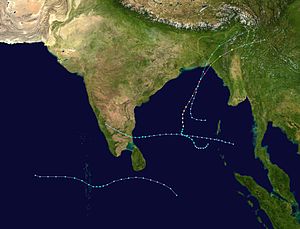| 1991 North Indian Ocean cyclone season | |
|---|---|
 Season summary map | |
| Seasonal boundaries | |
| First system formed | January 17, 1991 |
| Last system dissipated | November 16, 1991 |
| Strongest storm | |
| Name | BOB 01 |
| • Maximum winds | 235 km/h (145 mph) (3-minute sustained) |
| • Lowest pressure | 918 hPa (mbar) |
| Seasonal statistics | |
| Depressions | 8 official, 1 unofficial |
| Deep depressions | 4 |
| Cyclonic storms | 3 |
| Severe cyclonic storms | 1 |
| Very severe cyclonic storms | 1 |
| Extremely severe cyclonic storms | 1 |
| Super cyclonic storms | 1 |
| Total fatalities | >138,906 |
| Total damage | $1.7 billion (1991 USD) |
| Related articles | |
The 1991 North Indian Ocean Cyclone season was an extremely deadly and destructive season causing the deaths of more than 138,000 people and over $1.5 billion in damages. It was the period in which tropical cyclones formed to the north of the equator in the Indian Ocean. During the season tropical cyclones were monitored by the India Meteorological Department (IMD) and the Joint Typhoon Warning Center. The IMD assigned all depressions that it monitored with BOB followed by a number in numerical order. The JTWC also assigned a number and either the letter A or B depending on where the depression was when the first advisory was issued.
During the year there were eight depressions that were monitored by the IMD while the JTWC monitored four during the year of which one was not monitored by the IMD. The first cyclone of the year formed on January 17 and had little effect on ships that were moving through the Arabian sea to take part in the Gulf War. The deadliest cyclone during the year was Super Cyclonic Storm BOB 01, which killed over 138,000 people.